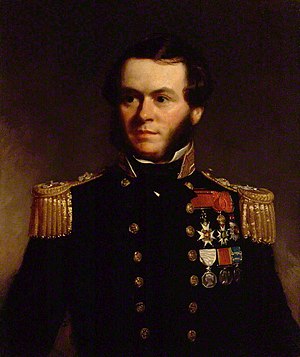Sherard Osborn
| Sherard Osborn | |
|---|---|

Sherard Osborn
|
|
| Born |
25 April 1822 Madras, India |
| Died | 6 May 1875 (aged 53) London, England |
| Allegiance |
|
| Service/branch |
|
| Rank |
|
| Commands held | |
| Battles/wars |
|
| Awards |
|
Sherard Osborn (25 April 1822 – 6 May 1875), was a Royal Navy admiral and Arctic explorer.
Born in Madras, he was the son of an Indian army officer. Osborn entered the navy as a first-class volunteer in 1837, serving until 1844 in Hyacinth, Clio & Volage.
In 1838, he was entrusted with the command of a gunboat at the attack on Kedah in the Malay Peninsula, and was present at the reduction of Canton in 1841 and at the capture of Woosung in 1842. From 1844 until 1848, he was gunnery mate and lieutenant in HMS Collingwood, the flagship of Sir George Seymour in the Pacific.
He took a prominent part in 1849 in advocating a new search expedition for Sir John Franklin, and in 1850 was appointed to the command of the steam-tender Pioneer in the Arctic expedition under Horatio Thomas Austin, in the course of which he performed (1851) a remarkable sledge-journey to the western extremity of Prince of Wales Island. He published an account of this voyage, entitled Stray Leaves from an Arctic Journal (1852), and was promoted to the rank of commander shortly afterwards.
In January 1852 he married Helen, daughter of John Hinksman of Queen Anne Street, London.
In the new expedition (1852–1854) under Sir Edward Belcher he again took part as commander of Pioneer. In 1856, he published the journals of Captain Robert McClure, giving a narrative of the discovery of the Northwest Passage.
...
Wikipedia
